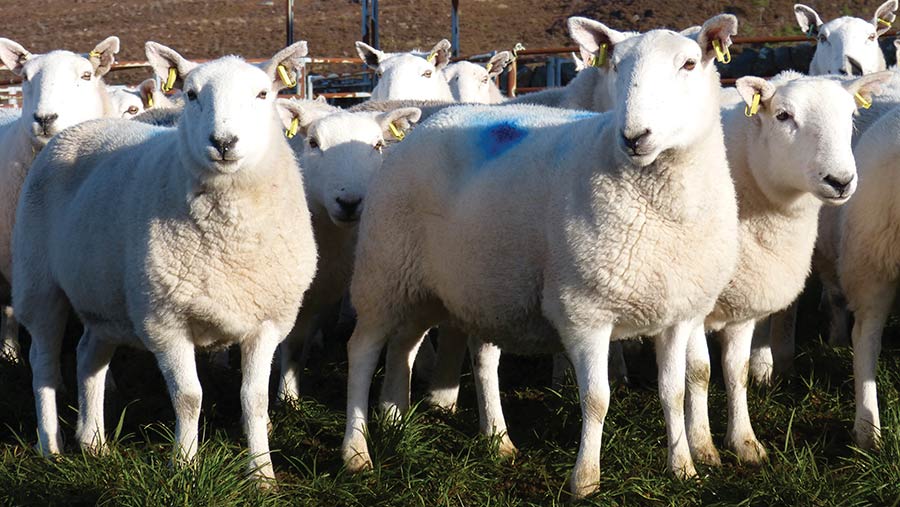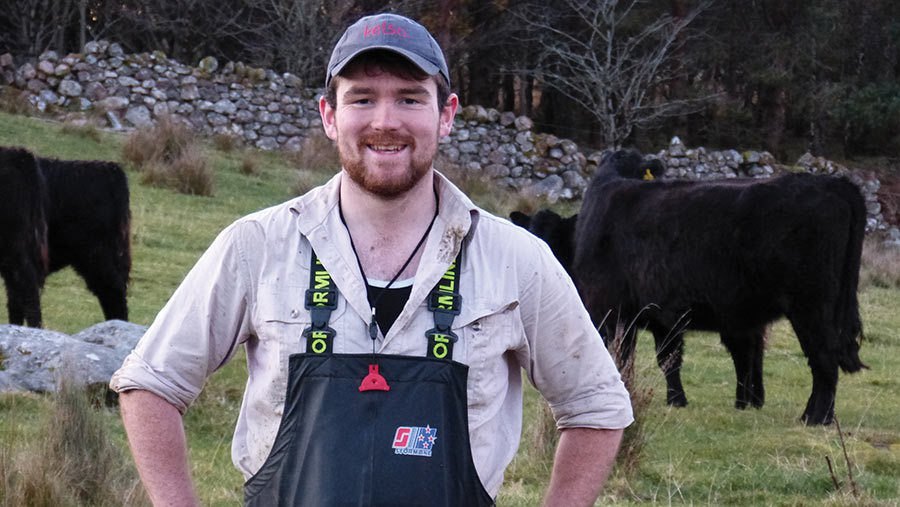How mineral blood test helps cut barren rates in Highlands flock
 © MAG/Michael Priestley
© MAG/Michael Priestley Analysis of ewe bloods for minerals in late gestation prompted a change in supplementation that has cut barren rates from 5% to 1.6% for an Aultbea-based sheep breeder.
Ryan MacLean has recorded just three empty sheep out of 120 in each of the past two scannings. His flock of mainly purebred North Country Hill Cheviots scanned at 127% and reared 1.22 lambs this year.
Informed by the metabolic profile results for his flock, he decided to use a mineral bucket to address a known copper deficiency in the area he grazes north of Poolewe in Wester Ross in the north-west Highlands of Scotland.
See also: Estate flock halves feed cost and lifts scan rate to 186%
Farm facts: Beiste Loch Cheviots
- 120 North Country Cheviots
- Tenant crofter
- 250ha (effective) hill rented at Achgarve
- Rents 3ha improved ground (for twins), 8ha of improved hill, and makes 3ha of silage
- Weaned lambs fattened on rented keep on the Black Isle and sold prime through Dingwall market
- Incheoch Texel and Fearn Farms Aberfield used as terminal sires
Challenging environment
Ryan’s ewes are a compact and hardy type averaging 55kg (range 40-67kg) when mature. They spend the bulk of the year around Loch na Beiste, near Achgarve, on a small peninsula north of Poolewe.
Like many crofters on the Highlands and Islands, Ryan has bred his sheep to rear mainly single lambs off low-quality grazing (mainly heather with some coarse grasses).
However, Ryan has tried three years of direct drilling to improve silage swards. Vetch and herbal leys have thrived particularly well, and he has also used an oat, pea and red clover mix.
Previous supplementation
Before metabolic profiles were taken, the sheep were being supplemented with an energy lick, ewe rolls in late gestation and a mineral bolus.
The bolus was replaced with a pre-tupping mineral drench supplying vitamin E and selenium.
“I don’t like administering boluses – it’s a time-consuming and invasive job that I did not feel was meeting ewes’ metabolic requirements,” explains Ryan.
Blood test
Now an annual job in the calendar, metabolic profiling is done through Conanvet, Gairloch, and analysed at the laboratory of the Royal (Dick) School of Veterinary Studies at the University of Edinburgh.
It involves the following:
- Conducted in February
- Five ewes carrying singles and five with twins are sampled
- Blood is tested for copper, magnesium, betahydroxybuterate (BHOB) (a proxy for mobilising fat reserves and energy balance), urea nitrogen, and albumin (protein)
- A summary of the flock, breed, size and the expected date of lambing and their nutrition is given to provide context to the results
- A two-page written analysis of the results is provided.
Test results
The first blood tests (done in 2021) revealed a magnesium and copper deficiency, which was rectified with a mineral bucket.
This year’s blood test results came back satisfactory for both, and only one ewe was below the 0.9mmol/litre threshold for BHOB.
Current supplementation
In the first year of using the mineral bucket, the ewes continued to be fed ewe rolls, but Ryan felt confident enough to stop feeding rolls in the run-up to the 2023 lambing.
Ryan has continued supplementing with a Rumevite cattle mineral and energy bucket containing copper to make up for a shortfall in the area. However, he plans to try to scale back inputs further.
The buckets are fed from teaser entry to mid-May.
This means they are out on the improved hill from the second week of November and then offered in lambing paddocks until ewes and lambs head to the heft at Beiste Loch in early summer.
“I am trying to feed silage earlier in January and reduce ewe rolls and wonder whether I could save on the mineral drench and the energy blocks in future winters.
“I’d love to be forage only, but in our climate, with nearly three metres of rainfall, I think mineral supplementation will remain a necessity.”
Initial concerns
Nutritionists advising Ryan were initially shocked to hear the ewes were getting access to a cattle mineral and energy bucket containing copper. However, like the Scottish Blackface, the Cheviot is very resilient to copper toxicity.
Ryan was requested by Rumenco to send the blood samples after feeding the buckets, which allayed fears around copper poisoning.
Time and cost
Mineral buckets and energy blocks represent an easy option for Ryan, who is an agricultural contractor (see “Contracting business”) and earns half his income scanning sheep seven days a week between January and March.
They can be put out and eaten as and when sheep need them, and positioned on the parts of the heft where he wants to encourage grazing, or near roads or tracks for ease.
The current winter feed cost is about £29.45, which includes:
- Mineral bucket £6.75 a ewe (one bucket does up to five ewes for the winter)
- Silage costed at £22 a bale, with 22 bales used (cost of fertiliser, wrapping and contractor), which is £5 a ewe. At 240kg of dry matter (DM)/bale, cost is 9.1p/kg DM
- Energy block £17 (one block does one ewe for a winter)
- Mineral dose about 70p a ewe.

Ryan MacLean © MAG/Michael Priestley
Contracting business
Ryan MacLean runs Highland Agricultural Contracting, which:
- Scans about 100,000 sheep annually
- Scans 14,000 suckler cows
- Shears 45-55,000 sheep with up to eight shearers and three rousies (helpers)
- Controls foxes for a crofters’ fox club near Poolewe
Lambing benefits
Alongside much lower barren rates, colostrum quality and lambing vigour have noticeably improved, adds Ryan.
Colostrum samples measure higher than 22% on the Brix refractometer reading, indicating sufficient immunoglobulins.
In addition, this year, sheep have been given more space to lamb. The previous lambing paddock was 1ha (2.5 acres) and sheep were pulled out to the next-door paddock as they lambed.
Now, ewes are given a 4-5ha (10-12.5ha) paddock, which has reduced mismothering and disease and made observing sheep easier.
Genetics
Improvements are rarely down to a single factor in farming, but the drop in barren rate appears to be largely due to nutritional changes, says Ryan.
However, the flock has made genetic progress since starting in 2009, when Ryan was 13.
Keppoch, Kinneras, Castle Grant, Grenitote, and Heathpool genetics have been used to develop the flock, and Ryan sold six rams last year.
This progress is making winter easier for ewes, as weaning dates can be brought forward as milk and maternal ability improve, says Ryan.
All gimmers lambed themselves this year, and ewes weaning less than 50% of their body weight are put to terminal sires or culled.
Zero tolerance is taken on issues with lambing, teeth, udders and feet.
Flock performance is charted through a home-made Excel-based performance recording system, including weaning efficiency, body condition and maternal behaviour score. He hopes to be Signet recorded next season.
Since 2019, weaning has advanced 30 days (now in mid-August), while weaning weights for singles have increased by 2.04kg to 26.84kg at 85 days old.
This means the flock is more productive: weaning lambs earlier, giving ewes an extra month to recover before tupping and wintering.
“Putting condition on ewes cheaply for an extra month is a big benefit and sets them up for wintering,” he says.
